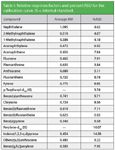Low Level PAH Detection with an Extensive Dynamic Range
The Application Notebook
The analysis of PAHs in less than 16 min using hydrogen as carrier gas and the PerkinElmer? Clarus? SQ 8 GC/MS operating in SIM mode is presented. Detection limits down to 0.5 pg on-column and a wide dynamic range are reported.
The analysis of PAHs in less than 16 min using hydrogen as carrier gas and the PerkinElmer® Clarus® SQ 8 GC/MS operating in SIM mode is presented. Detection limits down to 0.5 pg on-column and a wide dynamic range are reported.
Polycyclic aromatic hydrocarbons (PAHs) are one of the major categories of environmental pollutants and include known carcinogens. They are among the most common analytes environmental testing laboratories analyze and analytical techniques with high throughput are generally preferred. While many chromatographic methods are available to analyze these pollutants, the combination of gas chromatography–mass spectrometry (GC–MS) with hydrogen as a carrier gas provides high selectivity and confidence in compound identification with fast chromatographic times. Presented here are the results of analysis of PAH standards using the PerkinElmer (PKI) Clarus SQ 8 GC–MS operating with hydrogen carrier gas. The low detection limits required by the EPA for PAH compounds is achieved using single ion monitoring (SIM) mode which are otherwise not possible in standard scanning mode.
Experimental
The analytical system included a Clarus 680 GC operating with a capillary split/splitless injector, hydrogen as the carrier gas (2.0 mL/min), a Clarus Cup Split Glass Liner and an Elite-5MS (30 m ×0.25 mm i.d. × 0.25 µm) column. A Clarus SQ 8C mass spectrometer was the detector. PAH standards were prepared by serial dilution of commercially available standards from 0.0005 µg/mL to 5.0 µg/mL in methylene chloride solvent. Internal standards were added to each sample at a concentration of 0.1 µg/mL.
Results
Linear calibration results were obtained over the entire concentration range from 0.0005–5.0 µg/mL and the average relative response factors (avg. RRF) are presented in Table I. The low detection limits and extended dynamic range are a result of the newly improved electron multiplier based detector in the GC–MS system. This detector is designed to reduce noise while providing impressive signal gain across a range of responses. Each compound was identified and calibrated using a combination of its molecular ion and specific retention time. The use of hydrogen allows for excellent separation of isomeric compounds adding to the selectivity of the method.

Table I: Relative response factors and percent RSD for the calibration curve. IS = internal standard.
Conclusions
The Clarus SQ 8 GC–MS system from PerkinElmer was shown to provide extremely low level detection capability for PAH analysis. The selectivity provided by using the PKI Elite-5MS column with hydrogen as the carrier gas allowed chromatographic separation such that isomers as Benzo(b)- and Benzo(k)fluoranthene are individually defined.
PerkinElmer, Inc.
940 Winter Street, Waltham, MA 02451
Tel. (800) 762-4000, fax (203) 944-4904
Website: www.perkinelmer.com

Separation of Ultra-Short and Long Chain PFAS Compounds Using a Positive Charge Surface Column
December 11th 2024A separation of ultra-short and long chain PFAS (C1-C18) is performed on a HALO®PCS Phenyl-Hexyl column along with a HALO®PFAS Delay column which demonstrates excellent retention for both hydrophilic and hydrophobic analytes.

.png&w=3840&q=75)

.png&w=3840&q=75)



.png&w=3840&q=75)



.png&w=3840&q=75)














